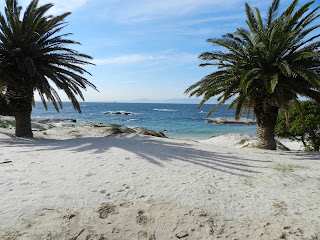2nd day in Johannesburg
Soweto
Pieter, our tour guide, informed us that Soweto gets its name from being the Southwestern Township of Johannesburg.
He told us that the Townships were created during apartheid to reinforce segregation, black African families were relocated there and some of the living conditions continue to be inadequate to support the needs of the families living there.
To begin the tour of Soweto we were joined by another local guide named Queen. She is a life long resident of Soweto and was able to provide an in depth and loving perspective of her home. She informed us that since the end of apartheid there have been many changes that have taken place there. Many of the people who had been renters in their homes were able to purchase the properties and are now owners. While 90% of the homes there have clean drinking water and electricity, there are still some families that do not have access to either of those basic needs.
Our guide, Queen, always keeps a copy of the Constitution with her. She explained that the picture on the front is a tree because of the tribal custom of the male elders in the tribe meeting under certain trees to discuss important decisions that needed to be made.
Soccer Balls
Our group anticipated visiting a school and donating some sports equipment and classroom materials. However, in an unexpected change of events we were unable to visit the school we originally planned on, so instead we pulled to the side of the road in Soweto and shared some of the sports equipment with some children in a neighborhood there. That brief encounter had a major impact on us as a group in a way we couldn't have imagined. The video below will hopefully give you an idea of what the experience was like. Special acknowledgement goes to Kerry Richmond and her Dad (Papa Richmond) for donating the soccer balls.
More to come on the other stops that were made today, which include:
Hector Pieterson Memorial & Museum
Mandela House
Apartheid Museum
Pieter, our tour guide, informed us that Soweto gets its name from being the Southwestern Township of Johannesburg.
He told us that the Townships were created during apartheid to reinforce segregation, black African families were relocated there and some of the living conditions continue to be inadequate to support the needs of the families living there.
To begin the tour of Soweto we were joined by another local guide named Queen. She is a life long resident of Soweto and was able to provide an in depth and loving perspective of her home. She informed us that since the end of apartheid there have been many changes that have taken place there. Many of the people who had been renters in their homes were able to purchase the properties and are now owners. While 90% of the homes there have clean drinking water and electricity, there are still some families that do not have access to either of those basic needs.
Queen our guide.
Houses in one neighborhood in Soweto
Kliptown Open Air Museum
Kliptown is one of the oldest districts in Soweto and is the place in which the Freedom Charter was originally passed in 1955. The Freedom Charter became the foundation for the Bill of Rights in the South African Constitution.
The sculptures above represent the 10 clauses in the Freedom Charter. Some of which are:
"The people shall share in the country's wealth."
"The land shall be shared by those that work it."
"All national groups shall have equal rights."
"There shall be peace and friendship."
Inside this building was further descriptions of the 10 clauses with a place for a flame to be lit in the middle.
Our group anticipated visiting a school and donating some sports equipment and classroom materials. However, in an unexpected change of events we were unable to visit the school we originally planned on, so instead we pulled to the side of the road in Soweto and shared some of the sports equipment with some children in a neighborhood there. That brief encounter had a major impact on us as a group in a way we couldn't have imagined. The video below will hopefully give you an idea of what the experience was like. Special acknowledgement goes to Kerry Richmond and her Dad (Papa Richmond) for donating the soccer balls.
More to come on the other stops that were made today, which include:
Hector Pieterson Memorial & Museum
Mandela House
Apartheid Museum









Comments
Post a Comment